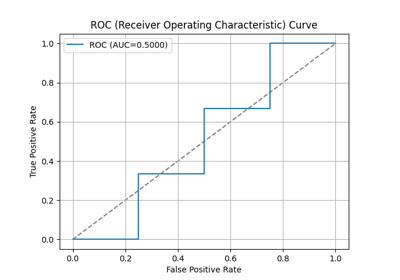aucplot#
- scikitplot.snsx.aucplot(data=None, *, x=None, y=None, hue=None, kind=None, weights=None, hue_order=None, hue_norm=None, palette=None, color=None, fill=False, baseline=False, line_kws=None, log_scale=None, legend=True, ax=None, annot=None, fmt='.4g', annot_kws=None, digits=None, common_norm=None, verbose=False, **kwargs)[source]#
AUC curve plot, Seaborn-style.
- Parameters:
- data
pandas.DataFrame,numpy.ndarray, mapping, or sequence Input data structure. Either a long-form collection of vectors that can be assigned to named variables or a wide-form dataset that will be internally reshaped.
- x, yvectors or keys in
data Variables that specify positions on the x and y axes.
- huevector or key in
data Semantic variable that is mapped to determine the color of plot elements.
- kind{‘pr’, ‘roc’} or None, default=None
Kind of plot to make.
if
'pr', the plot is pr curve;if
'roc', the plot is roc curve;if
None, the plot is roc curve.
- weightsvector or key in
data If provided, observation weights used for computing the distribution function.
- hue_ordervector of strings
Specify the order of processing and plotting for categorical levels of the
huesemantic.- hue_normtuple or
matplotlib.colors.Normalize Either a pair of values that set the normalization range in data units or an object that will map from data units into a [0, 1] interval. Usage implies numeric mapping.
- palettestring, list, dict, or
matplotlib.colors.Colormap Method for choosing the colors to use when mapping the
huesemantic. String values are passed tocolor_palette. List or dict values imply categorical mapping, while a colormap object implies numeric mapping.- color
matplotlib color Single color specification for when hue mapping is not used. Otherwise, the plot will try to hook into the matplotlib property cycle.
- fillbool or None
If True, fill in the area under univariate density curves or between bivariate contours. If None, the default depends on
multiple.- {line}_kwsdictionaries
Additional keyword arguments to pass to
plt.plot.- log_scalebool or number, or pair of bools or numbers
Set axis scale(s) to log. A single value sets the data axis for any numeric axes in the plot. A pair of values sets each axis independently. Numeric values are interpreted as the desired base (default 10). When
NoneorFalse, seaborn defers to the existing Axes scale.- legendbool
If False, suppress the legend for semantic variables.
- ax
matplotlib.axes.Axes Pre-existing axes for the plot. Otherwise, call
matplotlib.pyplot.gcainternally.- digitsint, optional, default=4
Number of digits for formatting output floating point values. When
output_dictisTrue, this will be ignored and the returned values will not be rounded.- output_dictbool, default=False
If True, return output as dict.
- zero_division{“warn”, 0.0, 1.0, np.nan}, default=”warn”
Sets the value to return when there is a zero division. If set to “warn”, this acts as 0, but warnings are also raised.
- common_normbool
If True, scale each conditional density by the number of observations such that the total area under all densities sums to 1. Otherwise, normalize each density independently.
- verbosebool, optional, default=False
Whether to be verbose.
- kwargs
Other keyword arguments are passed to one of the following matplotlib functions:
- data
- Returns:
matplotlib.axes.AxesThe matplotlib axes containing the plot.
Warning
Some function parameters are experimental prototypes. These may be modified, renamed, or removed in future library versions. Use with caution and check documentation for the latest updates.
- Parameters:
- Return type:

